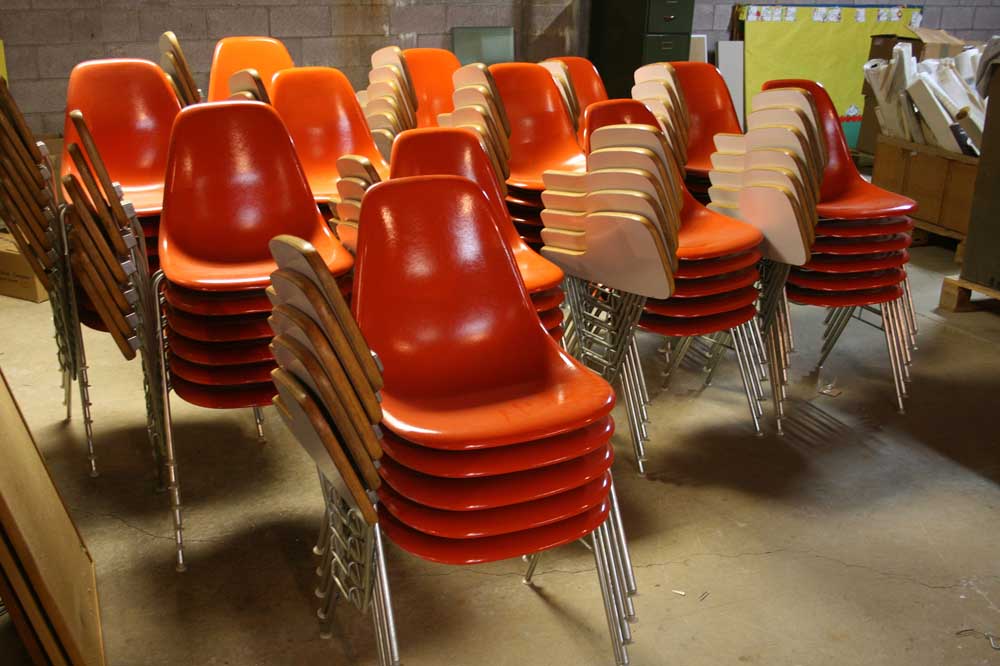Well Preserved: Astor Library’s fascinating basement
Published 11:10 am Tuesday, May 9, 2017

- Plastic molded chairs designed by Charles and Ray Eames — once used in the library's Flag Room — are stored in the basement.
ASTORIA — In January, Astoria’s City Council voted to renovate the existing public library rather than construct a new building elsewhere. A by-product of that decision means coming to terms with the library’s basement and its collection of historic books, newspapers, photos, furniture, etc. The basement — which covers a quarter of a city block — contains artifacts of real interest and value to our community.
All of the items will need to be relocated during the renovation… if the basement is converted to a public-occupied space. In the meantime, librarians, city staff and students from Clatsop Community College’s Historic Preservation program are sorting through the items, labeling them when necessary, and documenting their connection to the area’s history.
In 1948, the public library — which was both county and city operated — was housed on the first floor of the Astoria Elks Lodge where it had been since 1939. The light-filled space was quickly becoming inadequate. A community discussion put the library’s future on two separate tracks.
One track suggested a new library be constructed where it stands today. Supporters noted that modern libraries were more than books. Called “the people’s university,” it was said libraries should house picture collections, maps, recordings of music and speech, films and art. A place for lectures, forums and handicraft exhibitions was desired. The other track considered placing the library within the empty Capt. George Flavel mansion.
Both visions felt the new library should be county-wide, house a county museum and a veteran’s memorial. County librarian Phil Blodgett said using the Flavel house for a museum of “historical objets d’art” was “a temporary expedient.” A new library building was needed.
The quest to build a new library would span another 18 years. The desire to use it as a repository for relics and historic documents would span nearly half a century. In addition to private donations, the basement was used to store records from the County and City. Thankfully, the basement’s temperature and humidity are ideal for such storage.
Here is just a sampling of documents stored in the basement.
A cardboard box brimming with judgment rolls — or papers filed by the County’s clerk of the court — illustrate that life here today remains much as it was in the 1880s. There were numerous violations for hunting or fishing in the wrong location or during the wrong season. There was rampant alcohol and drug abuse, too.
There are also extraordinary crimes among the documents. William DeLashmutt’s 1883 arrest is among those detailed. Owner of the Ford Saloon on 9th and Bond streets, he “…feloniously, and without lawful authority, forcibly seized and confined, and kidnapped James Cannon with the intent to cause James Cannon to be sent out of the state of Oregon against his will….” In spite of a “spirited defense,” DeLashmutt served three years in the state penitentiary for his attempt to shanghai Cannon.
Among a scattering of other boxes are the personal collections of Astoria’s consummate historians, including handwritten notes on their favorite topics. For instance, August Hildebrand’s notes range from recollections of the Great Fire of 1922, to hiking our local peaks with the Angora Club, to his encounters with the Sikh community.
Polly McKean Bell, whose family settled here in 1848, recalls her father’s encounters with Capt. Flavel in a detailed account of historic Astoria. Russell Dark had a macabre sense of humor, but also a fascination with early bar pilots and the Port of Astoria.
Tucked within these collections are sometimes astonishing finds. Hildebrand, a German-American who was keenly interested in his native land’s military campaigns, donated a first edition print of a speech by Adolf Hitler in Nuremberg.
Dark also contributed an unknown blacksmith’s ledger whose accounts span the years 1817 to 1819. The ledger is not local, but there is a serendipitous aspect to it. A thick newspaper was used as its cover. Articles on that newspaper date to early 1817. One article notes the USS Ontario was in the Mediterranean. A year later, the USS Ontario entered the Columbia River and its captain, James Biddle, reclaimed Astoria from the British.
The variety and volume of documents can be overwhelming; the City of Astoria’s collection alone is expansive: City Council meeting notes from 1856 forward; leather-bound books holding long forgotten ordinances; Hilltop (Pioneer) Cemetery’s internment records with the names of scores of immigrants whose graves remain unmarked; and letters written to library patrons who misplaced their books, coupled with the written — sometimes comical — responses from those patrons.
These examples are only the beginning. The beauty of the basement’s collection is that it captures both large and small pieces of our history. It’s not simply the community’s elites or well-known voices telling the story. The voices of everyday people are recorded there. When taken as a whole, they tell a more complete story of Astoria’s rich history.
For more information about renovating an old home or commercial building, visit the Lower Columbia Preservation Society website at lcpsociety.com.


